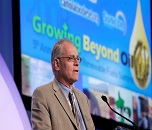
Ajit has more than 35 years of experience in the petroleum refining and petrochemicals business, technology development and management. He received his PhD from the University of Delaware and MBA from Cornell University. His experience includes technical and managerial assignments in research, engineering, licensing, business, manufacturing units and corporate planning. Ajit has strong management and technical background in refining, petrochemicals processes development, catalyst development, chemical reaction engineering, optimization technologies, computer integrated manufacturing and intellectual asset management. He has experience in upstream, downstream (refining, petrochemicals, polyester, lubes) and renewable energy sectors. He has published more than 100 technical papers, one book and has more than 45 U.S. patents to his credit.
Group President R&T, Reliance Industries Ltd
Theme: Exploring the Advancements in the Field of Biofuels & Bioenergy
Biofuels-2017
Conference series LLC Ltd invites all the participants from all over the world to attend 7th International Congress on Biofuels and Bioenergy during October 02-04, 2017 Toronto, Canada. This includes prompt keynote presentations, Oral talks, Poster presentations and Exhibitions. Theme of the Biofuels conference and Bioenergy conference is upgrading sources of energy for future generation with an objective to encourage young minds and their research abilities by providing an opportunity to meet the experts in the field of Biofuels, Bioenergy, Biomass and Biogas. Biofuels conference is designed to explore various applications in different fields.
Join us for two intensive and interesting days of discussing contemporary Biofuels and Bioenergy Expo research. We invite you to contribute and help to shape the Biofuels, Biogas, Biomass, Bio refineries, Bioenergy congress through submissions of your research abstracts, papers and e-posters. Bioenergy International is cordially inviting for presentation at the conference.
This conference will bring together experts from the world of government, law, industry, and agriculture to discuss emerging developments in the field of biofuels and renewable energy. This year's conference is of particular importance as the issue of biofuel as an alternative to fossil fuel has taken center stage in the United States. We are also honored to welcome the participation and supporters
WHY BIOFUELS? WHY NOW?
The emergence of biofuels as an alternative energy source has generated considerable excitement and controversy. Unsustainable levels of greenhouse gas emissions, mainly due to fossil fuel combustion, have led to increased focus on renewable energy sources. However, even as low emission fuels created from organic matter offer a beacon of hope for sustainable energy, they also present their own unique challenges. Critics claim that producing these fuels is itself fossil fuel intensive, obviating many of their benefits. In addition, rapid growth in demand for feedstock’s (i.e., corn, sugar, soybeans, etc.) could lead to the diversion of cropland from ‘food crops' to ‘fuel crops' and accelerate an international loss of biodiversity. Clearly, the issue presents both exciting implications and potential adverse impacts Canada has played a leadership role in the development of biofuels since few decades and the nation's increased reliance on their use offers a case study on the integration of biofuels into a growing economy. Indeed, during the next thirty years, Brazil aims to exchange the equivalent of 120 million tons of petroleum for agriculture energy. This concept of “agri energy” includes the expansion of the ethanol sector and the implementation of an efficient and sustainable chain of production for biofuels.
By contrast, the United States has only recently begun devoting significant resources to the field and is now investing heavily in new technologies to integrate biofuel extraction from its powerful agricultural production process. The U.S. expects to invest more than $10 billion on ethanol capacity and $1.8 billion on biodiesel in the near future; that investment is expected to fund the production of up to 6.5 billion gallons of ethanol and nearly two billion gallons of biodiesel.
The enormous promise of biofuels is matched only by the complexity of the issues they raise. This conference will offer a forum for experts from diverse disciplines to discuss and debate the pitfalls and promise of biofuels. In order to adequately explore the complex issues relating to biofuels as a source of renewable energy, their role in replacing fossil fuel and reducing greenhouse gases, and the related problems that would arise from such a shift, this year's conference will feature six panels exploring the issues from differing perspectives.
Introduction on biofuels industry next:
Solar panels, wind turbines and electric cars have become the most visible symbols of a global shift to renewable energies. But bioenergy holds significant potential to help speed the transition to a more sustainable and secure energy system. By 2050, a new generation of sustainable biofuels could provide over a quarter of the world’s total transport fuel, according to a recent report by the International Energy Agency. And biomass-based fuels offer the only viable low-carbon alternative to high energy density liquid fuels, including diesel and jet fuel.
To achieve that scenario, researchers are developing fuels from wastes, residues and non-fuel crops that are environmentally and socially sustainable
Conference Series Ltd invites you to attend the7th International Congress on Biofuels & Bioenergy which will be held on October 02-04, 2017 at Toronto, Canada. The theme of the conference is “Accelerating Advancements in the Field of Biofuels & Bioenergy”
Conference Series Ltd organizes a conference series of 3000+ Global Events with over 600+ Conferences, 1200+ Symposiums and 1200+ Workshops in USA, Europe & Asia with support from 1000 more scientific societies and publishes 700+ Open access journals which contains over 30000 eminent personalities, reputed scientists as editorial board members.
Track 1: Biomass
Biomass is biological material derived from living, or recently living organisms. It most often refers to plants or plant-based materials which are specifically called lingo cellulosic biomass. As an energy source, biomass can either be used directly via combustion to produce heat, or indirectly after converting it to various forms of biofuel. Conversion of biomass to biofuel can be achieved by different methods which are broadly classified into: thermal, chemical, and biochemical engineering methods. Wood remains the largest biomass energy source to date examples include forest residues (such as dead trees, branches and tree stumps), yard clippings, wood chips and even municipal solid waste. In the second sense, biomass includes plant or animal matter that can be converted into fibers or other industrial chemicals, including biofuels. Industrial biomass can be grown from numerous types of plants including miscanthus, switch grass, hemp, corn, poplar, willow, sorghum, sugarcane, bamboo, and a variety of tree species, ranging from eucalyptus to oil palm (palm oil). Biomass can be converted to other usable forms of energy like methane gas or transportation fuels like ethanol and biodiesel. There is research involving algal, or algae-derived, biomass due to the fact that it is a non-food resource and can be produced at rates five to ten times faster than other types of land-based agriculture, such as corn and soy. Using biomass as a fuel produces air pollution in the form of carbon monoxide, carbon dioxide, NOx (nitrogen oxides), VOCs (volatile organic compounds), particulates and other pollutants at levels above those from traditional fuel sources such as coal or natural gas in some cases (such as with indoor heating and cooking) Utilization of wood biomass as a fuel can also produce fewer particulate and other pollutants than open burning as seen in wildfires or direct heat applications. Black carbon – a pollutant created by combustion of fossil fuels, biofuels, and biomass – is possibly the second largest contributor to global warming. biomass conference are the best platforms to learn new ideas and advanced researches in the Biomass production and research field.
Conferences related to Biomass:
Seville, Spain;International Conference on Renewable Energy Resources, Jul 24-26, 2017, Vancouver, Canada;2nd Euro Global Biomass Summit and Expo, Sept 28-29, 2017, Brussels, Belgium; 5th Central European Biomass Conference, Jan 18-20, 2017, Graz, Austria; Biomass Power Association; The European Biomass Association;2nd Global Biomass Summit, Nov 6-8, 2017, San Antonio, USA; International Biomass congress and Expo, April 10-12, 2017, Minneapolis, MN;
Track 2: Biodiesel
Biodiesel is a form of diesel fuel manufactured from vegetable oils, animal fats, or recycled restaurant greases. It is safe, biodegradable, and produces less air pollutants than petroleum-based diesel. Biodiesel is meant to be used in standard diesel engines and is thus distinct from the vegetable and waste oils used to fuel converted diesel engines. Biodiesel can be used Biodiesel can be used in pure form, or blended with petro diesel in any proportions. Hydrogen and Biodiesel blends can also be used as heating oil. It also can be obtained from Pongamia, field pennycress and jatropha and other crops such as mustard, jojoba, flax, sunflower, palm oil, coconut and hemp. Multiple economic studies have been performed regarding the economic impact of biodiesel production. One study, commissioned by the National Biodiesel Board, reported the 2011 production of biodiesel supported 39,027 jobs and more than $2.1 billion in household income. Many countries around the world are involved in the growing use and production of biofuels, such as biodiesel, as an alternative energy source to fossil fuels and oil. The surge of interest in biodiesels has highlighted a number of Environmental Issues associated with its use. These potentially include reductions in green house gas emissions, deforestation, pollution and the rate of biodegradation. However, environmental organizations, for example, Rainforest Rescue and Greenpeace, criticize the cultivation of plants used for biodiesel production; they say the deforestation of rainforests exacerbates climate change and that sensitive ecosystems are destroyed to clear land for oil palm, soybean and sugar cane plantations. Moreover, that biofuels contribute to world hunger, seeing as arable land is no longer used for growing foods.
Conferences related to Biomass:
2nd World Biodiesel Congress and Expo, Dec 7-9, 2017, Atlanta, USA; 2nd International Chemical Engineering Conference, Oct 2-4, 2017, Chicago, USA; International Symposium on Green Chemistry, May 16-19, 2017, La Rochelle, France; National Biodiesel Conference and Expo, Jan 16-19, 2017, San Diego, USA; Biodiesel Association; Western Canada Biodiesel Association;
Track 3: Biogas
Biogas typically refers to a mixture of different gases produced by the breakdown of organic matter in the absence of oxygen. Biogas can be produced from raw materials such as agricultural waste, manure, municipal waste, plant material, sewage, green waste or food waste. It is a renewable energy source and in many cases exerts a very small carbon footprint. Biogas can be produced by anaerobic digestion with anaerobic bacteria, which digest material inside a closed system, or fermentation of materials by biodegradation. Biogas is primarily methane (CH4) and carbon dioxide (CO2) and may have small amounts of hydrogen sulphide (H2S), moisture and siloxanes. Biogas is produced as landfill gas (LFG), which is produced by the breakdown of biodegradable waste inside a landfill due to chemical reactions and microbes, or as digested gas, produced inside an anaerobic digester. By converting cow manure into methane biogas via anaerobic digestion, the millions of cattle in the United States would be able to produce 100 billion kilowatt hours of electricity, enough to power millions of homes across the United States. In fact, one cow can produce enough manure in one day to generate 3 kilowatt hours of electricity; the dangers of biogas are mostly similar to those of natural gas, but with an additional risk from the toxicity of its hydrogen sulfide fraction. Biogas can be explosive when mixed one part biogas to 8-20 parts air. Current research and advanced research techniques will be discussed at biofuels conference. Biofuels conference or Biomass conferences are going to be discuss advanced research techniques on Biogas.
Conferences related to Biomass:
International Conference on Progress in Biogas IV, March 8-11, 2017, Stuttgart, Germany; Wisconsin BioFuels Association; German Biofuel Association;2nd Global Biomass Summit, Nov 6-8, 2017, San Antonio, USA; International Symposium on Green Chemistry, May 16-19, 2017, La Rochelle, France; USA;3rd International Biofuels-Bioenergy Conference, Oct 2-4, 2017, Toronto, Canada; International Conference on Renewable Energy Resources, Jul 24-26, 2017, Vancouver, Canada;
Track 4: Bioethanol
The principle fuel used as a petroleum substitute is bioethanol. Bioethanol is mainly produced by the sugar fermentation process, although it can also be produced by the chemical process of reacting ethylene with steam. The main source of sugar required to produce ethanol comes from fuel or energy crops. These fuel crops are normally grown specifically for energy use and include maize, corn and wheat crops, waste straw, willow, sawdust, reed canary grass, cord grasses, Jerusalem artichoke, Myscanthus and sorghum plants. There is also ongoing research and development into the use of municipal solid wastes to produce ethanol fuel. Brazil and the United States account for over 70 percent of all ethanol production in the world today with the USA producing an estimated 6,500 Million gallons a year. Bioethanol produces only carbon dioxide and water as the waster products on burning, and the carbon dioxide released during fermentation and combustion equals the amount removed from the atmosphere while the crop is growing This fuel is not suitable for use in all cars and you should check compatibility with your vehicle manufacturer before using it. If in doubt use the standard SP95 or SP98 Octane unleaded fuel which continues to be available alongside the new fuel. Researchers have recently launched a proposal to cultivate massive amounts of seaweed or algae. They laims that the project could occupy about ten thousand kilometers of seaweed farm and they estimated that the farm would be able to produce bioethanol from algae, as much as 20 million kiloliters or 5.3 billion gallons of bioethanol per year. Biofuels Europe companies are conducting more research on Bioethanol. You can lean advanced research techniques and research guide lines at biomass conference and also biofuels 2016 conference.
Conferences related to Biomass:
Biobased World, February 15-16, 2017, Cologne, Germany; International Symposium on Green Chemistry, May 16-19, 2017, La Rochelle, France; Renewable Fuels Association; American Soybean Association;2nd World Bioenergy Congress and Expo, June 29-30, 2017 Madrid, Spain;19th Annual F.O. Licht's World Ethanol Biofuels, Nov 7 - 10 2016, Brussels, Belgium; 2nd World Bioenergy Congress , June 29-30, 2017 Madrid, Spain; 2nd Conference on Biomass Bioenergy
Track 5: Aviation Biofuels
Aviation biofuel is a biofuel used for aircraft. It is considered by some to be the primary means by which the aviation industry can reduce its carbon footprint. After a multi-year technical review from aircraft makers, engine manufacturers and oil companies, biofuels were approved for commercial use in July 2011. Since then, some airlines have experimented with using of biofuels on commercial flights. The focus of the industry has now turned to second generation sustainable biofuels that do not compete with food supplies. Drop-in" biofuels are biofuels that are completely interchangeable with conventional fuels. Deriving "drop-in" jet fuel from bio-based sources is ASTM approved via two routes. The first route involves using oil which is extracted from plant sources like Jatropha, algae, tallows, other waste oils, Babassu and camelina to produce bio-SPK (Bio derived synthetic paraffinic Kerosene) by cracking and hydro processing. The growing of algae to make jet fuel is a promising but still emerging technology. Companies working on algae jet fuel are Solazyme, Honeywell UOP, Solena, Sapphire Energy, Imperium Renewables, and Aqua flow Bionomic Corporation. The second route involves processing solid biomass using pyrolysis to produce pyrolysis oil or gasification to produce a syngas which is then processed into FT SPK (Fischer–Tropsch Synthetic Paraffinic Kerosene). The International Air Transport Association (IATA) supports research, development and deployment of alternative fuels. IATA thinks a 6% share of sustainable 2nd generation biofuels is achievable by 2020, and Boeing supports a target of 1% of global aviation fuels by 2015. This is in support of the goals of the aviation. biofuels brazil, biofuels 2016 conference are going to be discuss about advanced research on Aviation biofuels.
Conferences related to Aviation Biofuels:
The International Green Chemistry Conference, May 16-19, La Rochelle, France; North Carolina Biodiesel Association; Biodiesel Association of India;International Biochemical Engineering Conference, May 15-17 2017, Rome, Italy; North Carolina Biodiesel Association; Biodiesel Association of India;
Track 6: Food V/S Fuels Debate
In some poor countries the rising price of vegetable oil is causing problems. Some propose that fuel only be made from non-edible vegetable oils such as Camelina, Jatropha or seashore mallow which can thrive on marginal agricultural land where many trees and crops will not grow, or would produce only low yields. Others argue that the problem is more fundamental. Farmers may switch from producing food crops to producing biofuel crops to make more money, even if the new crops are not edible. The law of supply and demand predicts that if fewer farmers are producing food the price of food will rise. It may take some time, as farmers can take some time to change which things they are growing, but increasing demand for first generation biofuels is likely to result in price increases for many kinds of food. Some have pointed out that there are poor farmers and poor countries that are making more money because of the higher price of vegetable oil. There is ongoing research into finding more suitable crops and improving oil yield. Other sources are possible including human fecal matter, with Ghana building its first "fecal sludge-fed biodiesel plant. A group of Spanish developers working for a company called Ecofasa announced a new biofuel made from trash. The fuel is created from general urban waste which is treated by bacteria to produce fatty acids, which can be used to make biodiesel. Another approach that does not require the use of chemical for the production, it involves the use of genetically modified microbes. Biofuels 2016 or Biofuels Brazil conferences are going to conduct a debate on Food V/S Fuels.
Conferences related to Food and Fuels:
Illinois Soybean Association; Russian Biofuel Association;3rdInternational Biofuels-Bioenergy Conference,Oct 2-4, 2017,Toronto,Canada;Conference on Science, Policy and the Environment,Jan24-26,2017,Washington, DC;2nd World BioenergyCongressExpo, Jun 29-30, 2017, Madrid,Spain;InternationalBiochemical Engineering Conference, May 15-17 2017, Rome, Italy;Illinois Soybean Association; Russian Biofuel Association;
Track 7: Biorefineries
A biorefinery is a facility that integrates biomass conversion processes and equipment to produce fuels, power, and chemicals from biomass. The biorefinery concept is analogous to today's petroleum refineries, which produce multiple fuels and products from petroleum. Industrial biorefineries have been identified as the most promising route to the creation of a new domestic biobased industry. By producing multiple products; a biorefinery can take advantage of the differences in biomass components and intermediates and maximize the value derived from the biomass feedstock. A biorefinery might, for example, produce one or several low-volume, but high-value, chemical products and a low-value, but high-volume liquid transportation fuel, while generating electricity and process heat for its own use and perhaps enough for sale of electricity. The high-value products enhance profitability, the high-volume fuel helps meet national energy needs, and the power production reduces costs and avoids greenhouse-gas emissions.
Conferences related to Biorefinary:
3rd International Biofuels Bioenergy Conference, Oct 2-4 2017, Toronto, Canada; International Conference on Renewable Energy Resources, Jul 24-26, 2017, Vancouver, Canada; 2nd World Bioenergy Congress and Expo, June 29-30, 2017, Spain;Ontario BioFuels Association; Latvian Bioenergy Association; International Conference on Renewable Energy Resources, Jul 24-26, 2017, Vancouver, Canada; 13th Conference on Renewable Resources and Biorefineries, June 7 - 9, 2017, Wroclaw, Poland;
Track 8: Bioenergy
Bioenergy is renewable energy made accessible from materials acquired from biological origin. Biomass is any organic matter which has deposited sunlight in the form of chemical energy. As a fuel it may comprise wood, straw, wood waste, sugarcane, manure, and many other by-products from different agricultural engineering processes. In its most exclusive sense it is a synonym to biofuel, which is fuel obtained from biological sources. In its wider sense it includes biomass, the biological matter utilized as a biofuel, as well as the social, scientific, economic and technical fields related with utilizing biological sources for energy. This is a common misbelief, as bioenergy is the energy cultivated from the biomass, as the biomass is the fuel and the bioenergy is the energy stored in the fuel.
Conferences related to Bioenergy:
Bio based World, Feb 15-16, 2017, Cologne, Germany; Bioenergy Association of New Zealand; Southern African Bioenergy Association;3rd International Biofuels BioenergyConference, Oct 2-4 2017, Toronto, Canada; International Symposium on Green Chemistry, May 16-19, 2017, La Rochelle, France; 2nd World Bioenergy Congress, June 29-30, 2017 Madrid, Spain;International Conference on Renewable Energy Resources, July 24-26, 2017, Vancouver, Canada; 2nd World Bioenergy Congress and Expo, June 29-30, 2017 Madrid, Spain;
Track 9 : Algae Biofuels
Algal biofuel and Microbial Biofuels are an alternative to liquid fossil fuels that uses algae as its source of energy-rich oils. Several Biofuels America, Biofuels Brazil companies and government agencies are funding efforts to reduce capital and operating costs and make algae fuel production commercially viable. Like fossil fuel, algae fuel releases CO2 when burnt, but unlike fossil fuel, algae fuel and other biofuels only release CO2 recently removed from the atmosphere via photosynthesis as the algae or plant grew. With current technology available it is estimated that the cost of producing microalgal biomass is $2.95/kg for photobioreactors and $3.80/kg for open-ponds. These estimates assume that carbon dioxide is available at no cost. If the annual biomass production capacity is increased to 10000 tonnes, the cost of production per kilogram reduces to roughly $0.47 and $0.60, respectively. Assuming that the biomass contains 30% oil by weight, the cost of biomass for providing a liter of oil would be approximately $1.40 and $1.81 for photobioreactors and raceways, respectively. Oil recovered from the lower cost biomass produced in photo bioreactors is estimated to cost $2.80/L, assuming the recovery process contributes 50% to the cost of the final recovered oil. Numerous Funding programs have been created with aims of promoting the use of Renewable Energy. In Canada, the eco Agriculture biofuels capital initiative (eco ABC) provides $25 million per project to assist farmers in constructing and expanding a renewable fuel production facility. In Europe, the Seventh Framework Programme (FP7) is the main instrument for funding research. Similarly, the NER 300 is an unofficial, independent portal dedicated to renewable energy and grid integration projects. Biofuels 2016 is the best platform to lean advanced research in the field of Biofuels and Bio energy.
Conferences related to Bioenergy:
MinnesotaBioFuelsAssociation;IdBiofuelAssociation;InternationalChemicalEngineering and Biochemical Engineering Conference, May 15-17, 2017 Rome, Italy; 2ndWorld Bioenergy Congress and Expo, Jun 29-30, 2017, Madrid, Spain;3rd International Biofuels-Bioenergy Conference, Oct 2-4, 2017, Toronto, Canada; International Symposium on Green Chemistry, May 16-19, 2017, La Rochelle, France;
Track 10 : Bioeconomy
The Bioeconomy comprises those parts of the economy that use renewable biological resources from land and sea – such as crops, forests, fish, animals and micro-organisms – to produce food, materials and energy. It is an essential alternative to the dangers and limitations of our current fossil-based economy and can be considered as the next wave in our economic development. Bioeconomy ,biobased economy, bioeconomy or biotechonomy refers to all economic activity derived from scientific and research activity focused on biotechnology. In other words, understanding mechanisms and processes at the genetic and molecular levels and applying this understanding to creating or improving industrial processes. The term is widely used by regional development agencies, international organizations, biotechnology companies. It is closely linked to the evolution of the biotechnology industry. The ability to study, understand and manipulate genetic material has been possible due to scientific breakthroughs and technological progress. The bioeconomy encompasses the production of renewable biological resources and their conversion into food, feed, bio-based products and bioenergy via innovative and efficient technologies provided by Industrial Biotechnology. It is already a reality and one that offers great opportunities and solutions to a growing number of major societal, environmental and economic challenges, including climate change mitigation, energy and food security and resource efficiency. The ultimate aim of the bioeconomy is to help keep, innovative and prosperous by providing sustainable, smart and inclusive economic growth and jobs, and by meeting the needs of a growing population whilst protecting our environment and resources.
Conferences related to Bioenergy:
International Conference on Renewable Energy and Resources July 24-26, 2017 Vancouver, Canada; American Council on Renewable Energy, Renewable Fuels Association; World Sustainable Energy Days – European Pellet Conference, March 1-2, 2017 Weiss, Austria; International Biomass Expo, March 1-3, 2017 Tokyo, Japan ; International Conference Progress in Biogas, March 8-11, 2017 Stuttgart, Germany; 3rd Annual Congress on Biofuels and Bioenergy April 27-28, 2017 Dubai, UAE; International Conference on Chemical and Biochemical Engineering June 7-8, 2017 Milano, Italy
Track 11: Entrepreneurs Investment Meet
Summary:
The emergence of Biofuels production as an alternative energy source has generated considerable excitement. Unsustainable levels of greenhouse gas emissions mainly due to fossil fuels combustion, have led to increased focus on renewable energy sources.
Over the world, there has been a phenomenal enthusiasm for biofuels over the previous decade. The primary purpose behind this is the unpredictability in raw petroleum costs, which is influencing the monetary state of numerous nations that don't have critical oil and gas stores to bolster their developing economy. High reliance on non-renewable energizes has made monetary and in addition natural concerns, for example, rising nursery gas emanations. A few creating and created economies have executed administrative changes, mixing targets, and statutory standards while utilizing biofuels to counterbalance the developing natural dangers connected with routine powers. For more details please visit- http://biofuels-bioenergy.conferenceseries.com
Importance & Scope:
Increasing energy demand, environmental change and carbon dioxide (CO2) outflow from fossil fuels make it a high need to look for low carbon vitality assets. Biofuels have been progressively investigated as a conceivable option wellspring of fuel and speak to a key focus for the future vitality showcase that can assume an essential part in keeping up vitality security. It is basically considered as conceivably modest, low-carbon vitality source.
Biofuels-2017 is the occasion intended for the International experts to encourage the dispersal and utilization of exploration discoveries identified with Biofuels and Bioenergy as substitution powers. It is an investigative stage to meet kindred key chiefs all-around the Biotech associations, Academic Institutions, Industries, and Environment Related Institutes and so on, and making the congress an impeccable stage to share and pick up the information in the field of bioenergy and biofuels. Biofuels - 2017 is a stage to accumulate visionaries through the examination talks and presentations and set forward numerous interesting techniques of creation and scale up of renewable Energy and making the congress a flawless stage to share capability.
Global Biofuels Market Will Grow Steadily At A CAGR Of 5.87% during the Period 2016-2020: Research Moz
Why Canada…?
In Canada, environmental objectives rather than energy security has been the driver behind the development of federal and provincial policies and programs designed to encourage the development of a domestic renewable fuels industry. Approximately 17.8 billion liters of ethanol were produced in 2006, using 2.9 million hectares of land. In 2007, the Government of Canada committed to reducing Canada’s total GHG emissions by 20 percent from 2006 levels by 2020. Energy is a joint federal and provincial responsibility in Canada and it is for this reason that programs and incentives to support energy development are found at both levels of government. In Canada, many of the provincial governments put in place provincial biofuel blend mandates well ahead of the federal strategy for the development of a domestic renewable fuels industry that was put into place in 2006/2007. Due to the focus on at the federal level and provincial level on emissions, foreign suppliers can achieve a competitive edge by supplying lower carbon intensity (CI) fuels. This is particularly true in the case of ethanol. value paid to makers in 1980 was US$700 for 1000 liters; over the mediating years, picks up in innovation and economies of scale have driven the expense down, coming to as low as US$200 per 1000 liters in 2004. By 2004, ethanol in Canada had turned out to be financially focused with gas in light of worldwide costs for oil (proportionate to US$40 per barrel). At these costs, the creation of ethanol from sugarcane is much less expensive that from different harvests, for example, corn, wheat and sugar beet.
Why to attend???
Meet highly qualified and experienced Scientists from around the world Biofuels & Bioenergy, this is your single and best opportunity to reach the largest assemblage of participants from all over the world. Conduct demonstrations, distribute knowledge meet with highly qualified scientists, discuss new researches, and receive name recognition at this 3-day event. World-renowned speakers, the most recent techniques, tactics, and the newest updates in Biofuels and Bioenergy are hallmarks of this conference. Be Part of it! This conference focusing on all the major aspects in the fields of Biofuels & Bioenergy It would be beneficial for all the students who ever willing to enter into corporate as well as research fields targeting to the respective field. Chance to form alliance with emerging or established companies / Research institutes in the respective field.
Market analysis of Biofuels
The demand for biofuels is growing enormously. From the evidence available today, we believe that biofuels could, with developments in technology and favorable policy constitute up to 30% of the world transport fuel mix by 2030. The advantages of biofuels – whether in greenhouse gas benefits, energy security or rural development-mean that many governments are keen to foster the industry through current phases of technology development to deliver material scale and reduced costs. Our belief is that the industry can be developed sustainably, provided appropriate feedstock’s are grown, which do not adversely compete with food, using good land management to minimize environmental impact. This will require development of appropriate sustainability standards; it will not be easy, but by engaging in the industry, responsible businesses will work out appropriate business models and want to see enforcement of standards across the industry. This paper sets out the characteristics of the global fuels market, the significance of joint industry studies with car manufacturers and the choices around land use that society must make. The approach taken by BP is then described whereby guiding principles have been defined to set the boundaries of our impact on ecosystems. Characteristics of the biofuels market: its s size and growth rate. The world is in a state of biofuels fever. In 2006 biofuel constituted 49 bn liters, or 3%, of the 1,600 billion liter market for gasoline and diesel fuel. By 2015 the biofuels market is likely to have tripled to 155 billion liters. In practical terms that is an increase of around 10 billion liters per year over ten years. In terms of current ethanol yields of 5,250ltrs / ha, this equates to an increase of land use for biofuels of approximately 17,000 square km per year. The bulk of the global demand for ethanol and biodiesel comes from a few major regions. The USA accounted for very nearly 50% of global ethanol consumption in 2006, with Brazil taking 36% of global volumes. The EU accounted for 75% of global biodiesel consumption in 2006. The reason why we believe the feverish rate of growth is likely to materialize is because, with no carbon beneficial substitutes available in the near term, biofuels are being promoted by governments. Clear examples of this are the trends of regulations in the EU, and the intentions announced in the US. BP is already a major player in the global biofuels market. In 2006 BP blended 3,016 million liters of ethanol into gasoline – a 25% increase on the previous year. Thus BP is already well exposed to the biofuels fever – and the theme of this paper is to suggest how the industry can tap the heat of the fever in a positive sense.
For more details please click here
To share your views and research, please click here to register for the Conference.
To Collaborate Scientific Professionals around the World
| Conference Date | October 2-4, 2017 | ||
| Sponsors & Exhibitors |
|
||
| Speaker Opportunity Closed | Day 1 | Day 2 | Day 3 |
| Poster Opportunity Closed | Click Here to View | ||
Useful Links
Special Issues
All accepted abstracts will be published in respective Our International Journals.
- Journal of Fundamentals of Renewable Energy and Applications
- Journal of Petroleum and Environmental biotechnology
- Journal of Bioremediation & Biodegradation
Abstracts will be provided with Digital Object Identifier by
































































